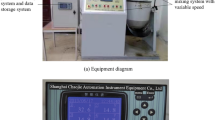Abstract
Water permeability is an important property for porous asphalt mixtures. Previous numerical modeling showed that the permeability of the porous asphalt mixtures varies in different directions and a single permeability cannot accurately evaluate the mixture’s directional permeability. To investigate the direction-dependent water permeability of the porous asphalt mixtures, a unidirectional permeameter was used to measure the permeability in twelve directions in the vertical plane (parallel to compaction direction) and twelve directions in the horizontal plane (perpendicular to the compaction direction) on two open graded friction course (OGFC) mixtures with different nominal maximum aggregate sizes, i.e., OGFC-13 and OGFC-10. Furthermore, a new multidirectional permeameter was designed which can control the rainfall intensity and adjust transverse slope to simulate the actual water flow process in pavement. The multidirectional permeability and void saturation of eight porous asphalt mixtures were determined by the multidirectional permeameter. Results show that the porous asphalt mixtures demonstrate direction-dependent permeability properties in both vertical and horizontal planes, whereas the dependence is less in the horizontal plane than that in the vertical plane. In the vertical plane, the minimum permeability occurs in the vertical direction and the maximum value occurs in the horizontal direction. In the horizontal plane, the permeability differs in different directions, but has no obvious relationship with directions. Increasing the air void content and the nominal maximum aggregate size of the mixtures can reduce the directional difference of the permeability. The void inside porous mixture cannot be entirely occupied by water when surface runoff occurs. Increasing the air void content and aggregate particle size can lead to an increase of the permeability and the void saturation in the porous asphalt mixtures.











Similar content being viewed by others
References
Colwill DM, Bowskill GJ, Nicholls JC, Daines ME (1993) Porous asphalt trials in the United Kingdom. Transp Res Rec 1427(1):13–21
Huber G (2000) Performance survey on open-graded friction course mixes. In: National Cooperative Highway Research Program (NCHRP) synthesis of highway practice 284. National Academies, Washington, DC
Fwa TF, Tan SA, Chuai CT, Guwe YK (2001) Expedient permeability measurement for porous pavement surface. Int J Pavement Eng 2(4):259–270
Tan SA, Fwa TF, Han CT (2003) Clogging evaluation of permeable bases. J Transp Eng 129(3):309–315
Yong CF, McCarthy DT, Deletic A (2013) Predicting physical clogging of porous and permeable pavements. J Hydrol 481:48–55
Alvarez AE, Martin AE, Estakhri C (2011) A review of mix design and evaluation research for permeable friction course mixtures. Constr Build Mater 25(3):1159–1166
Chen J, Li H, Huang X, Wu J (2015) Permeability loss of open graded friction course mixtures due to deformation-related and particle-related clogging: understanding from a laboratory investigation. J Mater Civ Eng 27(11):04015023
Zhang Y, Luo R, Lytton RL (2011) Microstructure-based inherent anisotropy of asphalt mixtures. J Mater Civ Eng 23(10):1473–1482
Zhang Y, Luo R, Lytton RL (2012) Anisotropic viscoelastic properties of undamaged asphalt mixtures. J. Transp Eng 138(1):75–89
Zhang Y, Luo R, Lytton RL (2014) Anisotropic characterization of crack growth in tertiary flow of asphalt mixtures in compression. J Eng Mech 140(6):04014032
Gu F, Luo X, Zhang Y, Lytton RL (2015) Using overlay test to evaluate fracture properties of field-aged asphalt concrete. Constr Build Mater 101:1059–1068
Gu F, Zhang Y, Luo X, Luo R, Lytton RL (2015) Improved methodology to evaluate fracture properties of warm-mix asphalt using overlay test. Transp Res Rec 2506(1):8–18
Masad E, Muhuthan B, Shashidar N, Harman T (1999) Internal structure characterization of asphalt concrete using image analysis. J Comput Civil Eng 13–2:88–95
Al-Omari A, Masad E (2004) Three dimensional simulation of fluid flow in X-ray CT images of porous media. Int J Numer Anal Meth Geomech 28:1327–1360
Hunter AE, Airey GD (2005) Numerical modeling of asphalt mixture site permeability. In: Proceedings of the 84th transportation research board annual meeting. CD-ROM, Washington, DC
Kutay ME, Aydilek AH, Masad E, Harman T (2007) Computational and experimental evaluation of hydraulic conductivity anisotropy in hot-mix asphalt. Int J Pavement Eng 8(1):29–43
Masad E, Al-Omari A, Chen HC (2007) Computations of permeability tensor coefficients and anisotropy of asphalt concrete based on microstructure simulation of fluid flow. Comput Mater Sci 40:449–459
Gruber I, Zinovik I, Holzer L, Flisch A, Poulikakos LD (2012) A computational study of the effect of structural anisotropy of porous asphalt on hydraulic conductivity. Constr Build Mater 36:66–77
Chen J, Wang H, Zhu H (2017) Investigation of permeability of open graded asphalt mixture considering effects of anisotropy and two-dimensional flow. Constr Build Mater 145:318–325
Chen J, Zhang Y, Li H, Gao Y (2016) Rutting-induced permeability loss of open graded friction course mixtures. J Test Eval 44(2):719–724
Acknowledgements
The research presented herein was sponsored by the National Natural Science Foundation of China (No. 51208178) and the Fundamental Research Funds for the Central Universities (No. 2015B17014).
Author information
Authors and Affiliations
Corresponding author
Rights and permissions
About this article
Cite this article
Chen, J., Tang, T. & Zhang, Y. Laboratory characterization of directional dependence of permeability for porous asphalt mixtures. Mater Struct 50, 215 (2017). https://doi.org/10.1617/s11527-017-1081-z
Received:
Accepted:
Published:
DOI: https://doi.org/10.1617/s11527-017-1081-z




